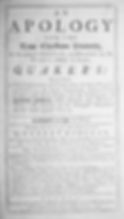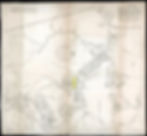Forbes in Colonial New Jersey
- Bart Forbes
- Aug 15, 2023
- 5 min read
After being imprisoned several times for attending illegal assemblies, devoted Quaker John Forbes of Aquhorthies became one of the first landowners in the Scottish colony of East Jersey in 1684.

Forbes was closely aligned with Robert Barclay of Urie (1648 – 1690) who was an eminent member of the Religious Society of Friends, or Quakers. Barclay wrote the influential treatise called An Apology for the True Christian Divinity: Being an explanation and vindication of the principles and doctrines of the people called Quakers. Not only was Barclay a fellow Quaker, but he was family, as well. Barclay’s daughters Patience and Catharine married Timothy Forbes and James Forbes, both sons of Alexander Forbes of Aquorthies. His youngest daughter Jean later married Alexander Forbes, son of John Forbes of Aquorthies.
Another influential Quaker, William Penn (1644 –1718), had founded the Province of Pennsylvania and in 1677 joined a group of prominent Quakers in purchasing the province of West Jersey. Barclay and a group of other Quaker proprietors purchased East Jersey in 1682. Among them were three officials in the Scottish government: Lord Chancellor James Drummond, 4th Earl of Perth; his brother Secretary of State John Drummond of Lundin (later 1st Earl of Melfort); and Chief Minister George Mackenzie, Lord Tarbat (later 1st Earl of Cromarty).
Barclay was selected as titular Governor of East New Jersey in 1682, even though he never lived there. For the day-to-day operations of the colony, he appointed a series of deputy governors. For the recruitment of new colonists, he turned to others, including his brother David Barclay and Arthur Forbes, brother of John Forbes of Aquorthies.
The proprietors commissioned the ship Exchange of Stockton, with Captain James Peacock, to sail from Aberdeen on August 31, 1683, with settlers, trade merchandise, supplies, and livestock. On that ship was Arthur Forbes and David Barclay. (Dobson, David. 1989. The Original Scots Colonists of Early America, 1612-1783. Baltimore, MD: Genealogical Publishing Co., Inc.) “David Barclay and his associate Arthur Forbes remained in East Jersey for some months, making an inspection of its resources and its potential trade, and on their return, prospective settlers were invited to consult them for first-hand information.” (Pomfret, John E. July 1953. “The Proprietors of the Province of East New Jersey, 1682-1702,” Pennsylvania Magazine of History and Biography.)

David Barclay and Arthur Forbes penned one of many endorsements that were printed in a booklet called An Advertisement Concerning the Province of East-New-Jersey in America: Published for the information of such as are desirous to be concerned therein, or to transport themselves thereto. (Scot, George. 1684. Edinburgh: John Reid)
Their letter dated March 5, 1684, from Aberdeen, provides great detail about the “healthfulness, pleasantness, and fertilty of the Countrey; its advantagious Scituation for Trade, and plenty and safety of excellent Herbors, and Inletts.” The letter also rebuts the specific claims made by Campbel: “As to that which John Campbel sayes, He hears that there is hardly any good Land untaken up, within 5. or 6. miles of a portable River; his Information has proved so for false, that David Mudie of Montrose, in his letter to his Wife, of the 12th of December, a moneth after, Declares, he had got 500 Acres, which was his full proportion of the first Division, upon a Navigable part of the South River.” (Forbes, Arthur; Barclay, David. 1684. An Advertisement Concerning the Province of East-New-Jersey in America. Edinburgh: John Reid)
Barclay and Forbes encourage others to join them in East Jersey: “we are sory, that any thing shauld appear, to stop our Countrey People, that are inclinable to go and settle there, for we are sure, that if they knew, and understood the nature of the Country, and how easily a man may procure a plen¬tifull Livelyhood, for his family in those parts, they would not account those that have rashly written these discouradging Letters their Friends.” (Ibid.) While Barclay purchased land in East Jersey, Forbes did not. He chose to return to Scotland.

One of the people who were persuaded to purchase property in East Jersey was Arthur Forbes’s brother, John Forbes of Aquorthies, son of John Forbes of Balfluig and Boyndlie. John had met up with his brother Arthur in Aberdeen when he returned from East Jersey in early 1684. By that time, John “had been fined and imprisoned a number of times in Aberdeen for attending illegal conventicles.” (Pomfret, John E. July 1953. “The Proprietors of the Province of East New Jersey, 1682-1702,” Pennsylvania Magazine of History and Biography.) John Forbes purchased a tenth share of property in July 1684 and quickly decided to venture forth, as he relates in a letter home: “But my resolution was so sudden, by the encouragement I received from the Chief Governor, and some of the Proprieters in Aberdeen, and having come in only to see my Sister with my Brother; and by the many Gentlemen that were going along in the ship, that I was induced to go along without so much as taking my leave of any of my Friends, save only these that were then in Town; so that I came of resolution only to see the place, and to settle onlie if I fand conveniency.” (Forbes, John. March 18, 1685. “A Letter from John Forbes Brother to Laird of Barnla,” The Model of the Government of the Province of East New Jersey in America. Edinburgh: John Reid.)
Unfortunately, his ship was disabled by a “mighty storm of wind” on September 12 that destroyed most the sails: “then being above 200 leagues from this land of America, tossing to and fro, expecting that each wave should overwhelm us.” (Ibid.) Fifteen days later, the ship arrived in “the Capes of Virginia” and “not being able to ply out her Voyage to this place (where she ought to have landed us, we were necessitate to travel from thence by Land to this place, being upwards of 200 English miles…” (Ibid.)

Forbes settled at Cedar Brook near the Blue Hills in East Jersey: “I went out to the woods to the land we had pitched upon, with several others of our Countrey men, such as Tho. Gordon, and Mr. Chat: his brother, brothers to the Laird of Straloch, Kinnabers two sons, Robert and Mr. Fullertons, James Johnston of Spotswood, and John Barclay the Governor’s brother, with some others.” (Ibid.) He also brought with him three indentured servants: Margaret Anderson, Andrew Craige, and James Smith. (Early Land Records, 1650 -1900s, State of New Jersey Department of State.)
Forbes was not planning to remain in East Jersey: “that I expect over this ensuing summer; and so to divide our said parcels, and improve them for a year or two to the best advantage, and then to sell them off. If I design to come home, which we can do at a good profite.” (Forbes, John. March 18, 1685. “A Letter from John Forbes Brother to Laird of Barnla,” The Model of the Government of the Province of East New Jersey in America. Edinburgh: John Reid.) He observed that “So that a man being once settled two or three years in it, and having Corn, Cattle, and all things necessary for the use of man within himself. And the trouble and hardship of his first settling by his hand; He may live as comfortably here as in any place of the World; Providing he could dispence with the want of his Friends and Relations, and the satisfaction of their Companie, which is the loss I most regrate in this place.” (Ibid.)
In addition to the land he purchased in July 1684, Forbes acquired at least 1,600 acres of land through deeds recorded on February 11, 1685; March 11, 1685; November 21, 1685; and May 18, 1686. (Early Land Records, 1650 -1900s, State of New Jersey Department of State.) As he noted in his letter home, he developed the property and then returned to Scotland: “He returned home, as he had planned, after locating his lands, and on his departure in 1686, he appointed Robert Hardy his agent.” (Pomfret, John E. July 1953. “The Proprietors of the Province of East New Jersey, 1682-1702,” Pennsylvania Magazine of History and Biography.)
